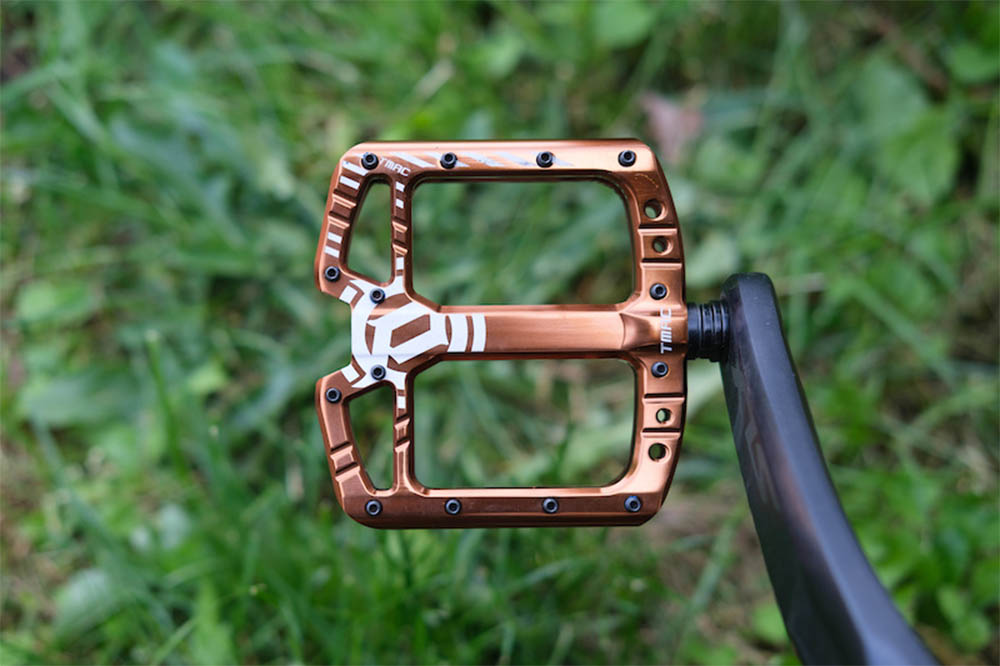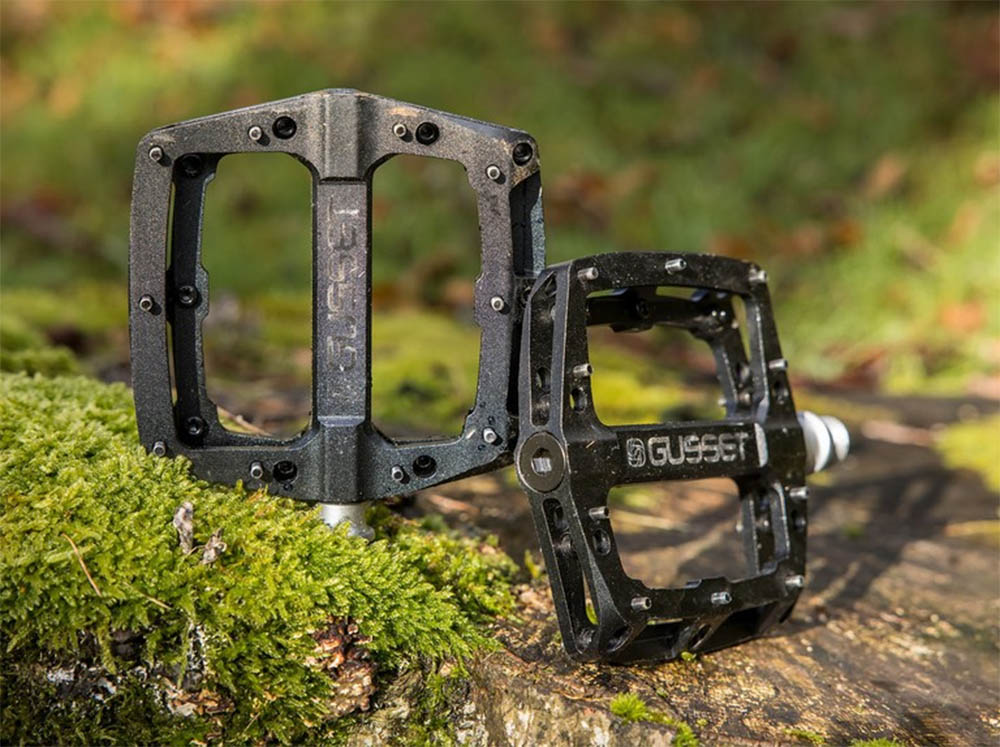Flat Pedals: My List of Pros and Cons

When choosing pedals for your bike, you have two main options. This guide outlines the pros and cons of flat pedals to help you decide which is best for your riding style. I’ll also discuss knee pain and outline some of the different clipless systems available.
Advantages of flat pedals
Flat pedals reduce the risk of injury – because your feet can move freely on the pedals, you won’t inadvertently cause knee pain or joint damage due to improper adjustment like clipless pedals. If you put your foot in an unnatural position, you will instinctively move it to avoid discomfort and pain.
You’re less likely to crash or fall – if you have to put your foot down in an emergency for whatever reason, you can. No need to think about unpacking. This greatly reduces the likelihood of a fall. If you do crash, it’s not that bad with flat pedals.
Riding flat pedals is cheaper – you don’t need to buy special shoes, cleats or pedals. You can get a cheap pair of flat pedals for just a few bucks at any bike store. You can ride with the shoes you already have.
You don’t need to adjust or set cleats – with flat pedals, your body will naturally place your feet in a comfortable and healthy position. This saves you from getting out of the car and messing with the cleats.
You can buy flat pedals anywhere in the world – even in the most remote areas, you can buy a pair of flat pedals. Every bike shop has them. They are standard parts in standard sizes. This makes it easy to find alternatives and gets you back on the road faster.
You don’t have to wear special shoes – you can wear any shoes, boots or sandals. This is fine if you just want to get on your bike and go to the grocery store. If you ride in the winter, you can wear boots to keep your feet warm. You don’t have to wear specific shoes to ride a bike. You can even ride barefoot if you want, but this is not recommended for safety reasons.
Flat pedals allow you to easily adjust your foot position – after a long day on the bike, it’s nice to be able to move your feet on the pedals to avoid fatigue. When touring, I sometimes use the center of my foot or heel for a while to give the ball of my foot a break.
You can walk comfortably in the same shoes as you ride – no need to carry a second pair of shoes while riding. This is especially good for cycling tours, where you want to be able to walk around and explore on your bike. It’s also fine if you hike a lot by bike.
Flat pedals are better for learning proper technique – if you are new to cycling, start with flat pedals. There are many bike control skills that are best learned on flat pedals, as they are more confidence-inspiring and less likely to get injured while learning. You can also avoid learning some bad habits that clipless can teach you. Before switching to clipless, you may want to learn some mountain biking skills, including front and rear wheel lifts, bunny hops, and J hops. These help you avoid obstacles and ride faster.
Some riders feel that flat pedals are easier on their knees – clipless pedals can lead to overuse injuries over time because they keep your feet and legs together, according to this funny video firmly in the same position. It can be difficult for a joint to move your legs the exact same way over and over. Flat pedals allow you to make small adjustments to your feet so you don’t use your joints in the same way every time you pedal. That being said, science does not support this claim. Clipless pedals have float to overcome this problem. I thought I’d bring this up for your consideration anyway.
Flat pedals have a lower center of gravity – this makes the bike feel more stable.
You don’t have to learn new skills – most of us started using flat pedals as children. We already have its muscle memory. Learning a new skill can be difficult and time-consuming. Sometimes it’s best to stick to what we know. Especially for casual or casual cyclists. Having said that, learning new skills is always a good thing.
Flat pedals make getting on and off the bike easy – no need to think about getting off. You don’t have to worry about starting off a hill and missing a clip.
Flat pedals are better for extreme conditions – when riding in very hairy conditions, you will be happy to have flat pedals. For example, riding through slippery snow, deep sand, mud, dangerously steep hills or crowded cities. If you have to put your feet down in a hurry, flats are best.

Disadvantages of flat pedals
Flat pedals give you less control – it’s more difficult to lift wheels or jump over obstacles with flat pedals. For example, maybe you see a rut on an upcoming trail and you need to move the rear wheel 3 inches to the right to avoid it. With clipless pedals, you can easily lift or slide the wheel where you want it. If you jump or lift your legs, your bike takes it with you. The same can be done with flat pedals. Just need more skill. You just can’t navigate obstacles quickly and accurately with the flat pedals.
Pulling the pedals up is impossible – with flat pedals, you can only apply power on the downstroke. With a good pair of pedals, grippy shoes, and proper technique, you can grab and apply power for most of your stroke, but you’ll never be able to pull up. Pull up is really convenient to climb the long mountain. I know it’s not the correct technique, but when your legs reach the point of fatigue, the pull up is a great tool. This is probably the thing I miss the most about riding flat pedals. It’s good to take a break from your leg muscles every now and then.
You can’t apply as much power with flat pedals – because your feet aren’t always in the ideal position, you usually don’t generate maximum power. This is noticeable when climbing steep hills or trying to accelerate quickly. With practice and good technique, you can match clipless performance. Some riders even use flat pedals for more power.
Flat pedals make it harder to maintain a high cadence—which is why few road cyclists use flat pedals these days. The average cyclist rides at about 60 RPM. Professionals ride at 80-100 RPM. If you hit a high tempo with flat pedals and you slow down your legs or make a mistake, your flat pedals can maintain a faster pace than your legs. This interrupts your entire pedaling rhythm and slows you down. When you’re tired, you tend to start pedaling erratically. When this happens, it’s easy to miss a stroke or slip your foot off the flat pedal. Clipless pedals ensure the cranks keep moving at the same cadence you pedal and your feet stay in place, even when you pedal at a high cadence.
Flat pedals make the bike wider – Most flat pedals have large platforms for extra support for your feet. The wider profile makes your bike wider so you can’t easily pass through tight gaps between trees and rocks. This makes it easy to hang up on certain parts of the trail.
You can’t cover the ground as fast as possible with flat pedals – flat pedals will average slightly slower due to the reduced power. For example, maybe while touring, you average 1 mile per hour slower than with a clipless system. Over long distances, this adds up. On a month-long trip, maybe you only ran 1000 miles, and you could use the same amount of energy and spend the same amount of time in the saddle to run 1200 miles without clips. Depending on your touring style, this may matter.

Flat pedals make certain skills and tricks harder to perform – core skills like jumping, drifting, sliding, wheel lifting take a lot of time and practice to learn. Most of these moves are difficult to accomplish with flat pedals.
Flat pedals are heavier – they are large flat pieces of metal. If you’re the type of person who cares about every ounce on your bike, flat pedals aren’t ideal. Lighter plastic models are available, but are less durable.
Your feet may slip – this is common when riding in rough or slippery conditions. Your feet can bounce off. The result is a missed stroke, which slows you down.
Your calves and calves get hit — when your feet slip off, the pedals usually end up hitting your legs, causing cuts and bruises. This can cause some severe pain and fear.
Flat pedals are out – if you want to always keep up with the latest trends, flat pedals are out of fashion right now. I don’t really care about this sort of thing, but some cyclists do.
Flat pedals and shoes are less technologically advanced – most pros don’t use flat pedals anymore, so bike companies put far less money and effort into developing flat equipment. When you pedal, you’re not getting the latest, most advanced gear.
If you are looking for a new way of commuting or want a healthier lifestyle, we are here to help you. Visit our website to learn more about electric bikes and electric scooter or please leave information to us.
 Shuangye ebike
Shuangye ebike
